Deck 8: Monopoly
سؤال
سؤال
سؤال
سؤال
سؤال
سؤال
سؤال
سؤال
سؤال
سؤال
سؤال
سؤال
سؤال
سؤال
سؤال
سؤال
سؤال
سؤال
سؤال
سؤال
سؤال
سؤال
سؤال
سؤال
سؤال
سؤال
سؤال
سؤال
سؤال
سؤال
سؤال
سؤال
سؤال
سؤال
سؤال
سؤال
سؤال
سؤال
سؤال
سؤال
سؤال
سؤال
سؤال
سؤال
سؤال
سؤال
سؤال
سؤال
سؤال
سؤال
سؤال
سؤال
سؤال
سؤال
سؤال
سؤال
سؤال
سؤال
سؤال
سؤال
سؤال
سؤال
سؤال
سؤال
سؤال
سؤال
سؤال
سؤال
سؤال
سؤال
سؤال
سؤال
سؤال
سؤال
سؤال
سؤال
سؤال
سؤال
سؤال
سؤال

فتح الحزمة
قم بالتسجيل لفتح البطاقات في هذه المجموعة!
Unlock Deck
Unlock Deck
1/175
العب
ملء الشاشة (f)
Deck 8: Monopoly
1
Alcoa had a monopoly in the U.S. aluminum market from the late nineteenth century until the end of World War II. Which barrier to entry was the source of Alcoa's monopoly power?
A) Ownership of a vital resource.
B) Government franchises and licenses.
C) Patents and copyrights.
D) Economies of scale.
A) Ownership of a vital resource.
B) Government franchises and licenses.
C) Patents and copyrights.
D) Economies of scale.
A
2
An industry is said to be a natural monopoly when:
A) legal barriers limit entry into the market.
B) diseconomies of scale are present in the market.
C) the market demand for the product supplied by a firm is inelastic.
D) long-run average cost continues to decline as the quantity of output increases.
A) legal barriers limit entry into the market.
B) diseconomies of scale are present in the market.
C) the market demand for the product supplied by a firm is inelastic.
D) long-run average cost continues to decline as the quantity of output increases.
D
3
Which of the following firms operates in a natural monopoly?
A) Telephone company.
B) Electric company.
C) Water company.
D) All of the above.
A) Telephone company.
B) Electric company.
C) Water company.
D) All of the above.
D
4
A monopolist faces a downward-sloping demand curve because:
A) the demand for its product is inelastic.
B) the industry demand curve is horizontal.
C) resource prices increase as the monopolist expands output.
D) the entire market demand curve is the monopolist's demand curve.
A) the demand for its product is inelastic.
B) the industry demand curve is horizontal.
C) resource prices increase as the monopolist expands output.
D) the entire market demand curve is the monopolist's demand curve.

فتح الحزمة
افتح القفل للوصول البطاقات البالغ عددها 175 في هذه المجموعة.
فتح الحزمة
k this deck
5
Which of the following is true under natural monopoly?
A) The marginal cost curve will be above the average cost curve.
B) The monopolist will set price equal to marginal cost and will earn economic profits.
C) Economies of scale exist.
D) Output is produced under conditions of constant cost.
A) The marginal cost curve will be above the average cost curve.
B) The monopolist will set price equal to marginal cost and will earn economic profits.
C) Economies of scale exist.
D) Output is produced under conditions of constant cost.

فتح الحزمة
افتح القفل للوصول البطاقات البالغ عددها 175 في هذه المجموعة.
فتح الحزمة
k this deck
6
An industry in which total costs are kept to a minimum because only one firm serves the whole market is called a:
A) natural monopoly.
B) competitive monopoly.
C) patent monopoly.
D) limit monopoly.
A) natural monopoly.
B) competitive monopoly.
C) patent monopoly.
D) limit monopoly.

فتح الحزمة
افتح القفل للوصول البطاقات البالغ عددها 175 في هذه المجموعة.
فتح الحزمة
k this deck
7
Which of the following factors is not a barrier to entry?
A) legally enforced patent rights
B) an inelastic demand for a product
C) licensing
D) control over an essential resource
A) legally enforced patent rights
B) an inelastic demand for a product
C) licensing
D) control over an essential resource

فتح الحزمة
افتح القفل للوصول البطاقات البالغ عددها 175 في هذه المجموعة.
فتح الحزمة
k this deck
8
The demand curve a monopolist faces:
A) is more elastic than a perfectly competitive firm's demand curve.
B) is the market demand curve.
C) is as elastic as a perfectly competitive firm's demand curve.
D) is not affected by the prices of complements.
E) will not shift in response to a change in consumer tastes.
A) is more elastic than a perfectly competitive firm's demand curve.
B) is the market demand curve.
C) is as elastic as a perfectly competitive firm's demand curve.
D) is not affected by the prices of complements.
E) will not shift in response to a change in consumer tastes.

فتح الحزمة
افتح القفل للوصول البطاقات البالغ عددها 175 في هذه المجموعة.
فتح الحزمة
k this deck
9
Which of the following is a market structure of monopoly?
A) Few firms operating as price takers.
B) Single firm operating as a price taker.
C) Single firm that is a price maker.
D) All of the above are true.
A) Few firms operating as price takers.
B) Single firm operating as a price taker.
C) Single firm that is a price maker.
D) All of the above are true.

فتح الحزمة
افتح القفل للوصول البطاقات البالغ عددها 175 في هذه المجموعة.
فتح الحزمة
k this deck
10
Which of the following is not associated with the monopoly market structure?
A) Many sellers.
B) A single seller.
C) A unique product.
D) Impossible entry into the market.
A) Many sellers.
B) A single seller.
C) A unique product.
D) Impossible entry into the market.

فتح الحزمة
افتح القفل للوصول البطاقات البالغ عددها 175 في هذه المجموعة.
فتح الحزمة
k this deck
11
A monopolized market is characterized by:
A) a sole seller of a product for which there are few suitable substitutes.
B) very strong barriers to entry.
C) a single firm facing the market demand curve.
D) all of the above.
A) a sole seller of a product for which there are few suitable substitutes.
B) very strong barriers to entry.
C) a single firm facing the market demand curve.
D) all of the above.

فتح الحزمة
افتح القفل للوصول البطاقات البالغ عددها 175 في هذه المجموعة.
فتح الحزمة
k this deck
12
Which of the following firms best fits the definition of a monopoly?
A) General Motors
B) Exxon Mobile
C) Local electric utility
D) AT&T
A) General Motors
B) Exxon Mobile
C) Local electric utility
D) AT&T

فتح الحزمة
افتح القفل للوصول البطاقات البالغ عددها 175 في هذه المجموعة.
فتح الحزمة
k this deck
13
A monopolist faces a downward sloping demand curve that is equal to which of the following?
A) The prevailing market price.
B) The market demand curve.
C) Its marginal cost curve.
D) Marginal revenue.
A) The prevailing market price.
B) The market demand curve.
C) Its marginal cost curve.
D) Marginal revenue.

فتح الحزمة
افتح القفل للوصول البطاقات البالغ عددها 175 في هذه المجموعة.
فتح الحزمة
k this deck
14
The demand curve any monopolist uses in making output decisions is:
A) the same as the demand curve facing a perfectly competitive firm.
B) vertical, because there are no close substitutes for its product.
C) horizontal, because there are no close substitutes for its product.
D) the same as the market demand curve.
E) perfectly inelastic.
A) the same as the demand curve facing a perfectly competitive firm.
B) vertical, because there are no close substitutes for its product.
C) horizontal, because there are no close substitutes for its product.
D) the same as the market demand curve.
E) perfectly inelastic.

فتح الحزمة
افتح القفل للوصول البطاقات البالغ عددها 175 في هذه المجموعة.
فتح الحزمة
k this deck
15
A natural monopoly is a market where:
A) a single firm has control over a vital natural resource.
B) many smaller firms can produce the entire market output at the same per-unit cost as could one large firm.
C) a single large firm can produce the entire market output at a lower per-unit cost than a group of smaller firms.
D) many smaller firms can produce the entire market output at a lower per-unit cost than could one large firm.
A) a single firm has control over a vital natural resource.
B) many smaller firms can produce the entire market output at the same per-unit cost as could one large firm.
C) a single large firm can produce the entire market output at a lower per-unit cost than a group of smaller firms.
D) many smaller firms can produce the entire market output at a lower per-unit cost than could one large firm.

فتح الحزمة
افتح القفل للوصول البطاقات البالغ عددها 175 في هذه المجموعة.
فتح الحزمة
k this deck
16
What is the name of the monopolist having a declining long-run average cost throughout the market?
A) Monopolistic competition.
B) Monopoly by legal barrier.
C) Natural monopoly.
D) Contrived monopoly.
A) Monopolistic competition.
B) Monopoly by legal barrier.
C) Natural monopoly.
D) Contrived monopoly.

فتح الحزمة
افتح القفل للوصول البطاقات البالغ عددها 175 في هذه المجموعة.
فتح الحزمة
k this deck
17
A monopoly is:
A) a seller of a highly advertised and differentiated product in a market with low barriers to entry in the long run.
B) the only seller of a good for which there are no good substitutes in a market with high barriers to entry.
C) the only buyer of a unique raw material.
D) the producer of a product subsidized by the government.
A) a seller of a highly advertised and differentiated product in a market with low barriers to entry in the long run.
B) the only seller of a good for which there are no good substitutes in a market with high barriers to entry.
C) the only buyer of a unique raw material.
D) the producer of a product subsidized by the government.

فتح الحزمة
افتح القفل للوصول البطاقات البالغ عددها 175 في هذه المجموعة.
فتح الحزمة
k this deck
18
The monopolist's demand curve is:
A) identical to the market demand curve.
B) identical to the marginal revenue curve.
C) below the marginal revenue curve.
D) a horizontal line at the market price.
E) a U-shaped curve.
A) identical to the market demand curve.
B) identical to the marginal revenue curve.
C) below the marginal revenue curve.
D) a horizontal line at the market price.
E) a U-shaped curve.

فتح الحزمة
افتح القفل للوصول البطاقات البالغ عددها 175 في هذه المجموعة.
فتح الحزمة
k this deck
19
Monopoly is a market structure characterized by a:
A) single firm operating as a price taker.
B) few firms operating as price takers.
C) single firm that is not a price taker.
D) none of the above.
A) single firm operating as a price taker.
B) few firms operating as price takers.
C) single firm that is not a price taker.
D) none of the above.

فتح الحزمة
افتح القفل للوصول البطاقات البالغ عددها 175 في هذه المجموعة.
فتح الحزمة
k this deck
20
Which barrier to entry results in the creation of a natural monopoly?
A) Legal barriers like government franchises.
B) Economies of scale.
C) Ownership of a vital resource.
D) Patents and copyrights.
A) Legal barriers like government franchises.
B) Economies of scale.
C) Ownership of a vital resource.
D) Patents and copyrights.

فتح الحزمة
افتح القفل للوصول البطاقات البالغ عددها 175 في هذه المجموعة.
فتح الحزمة
k this deck
21
When marginal revenue is zero for a monopolist facing a downward-sloping straight-line demand curve, the price elasticity of demand is:
A) greater than 1.
B) equal to 1.
C) less than 2.
D) equal to 0.
A) greater than 1.
B) equal to 1.
C) less than 2.
D) equal to 0.

فتح الحزمة
افتح القفل للوصول البطاقات البالغ عددها 175 في هذه المجموعة.
فتح الحزمة
k this deck
22
Graphically, the marginal revenue curve of a monopolist:
A) will sometimes lie below the demand curve of the monopolist.
B) will always lie below the demand curve of the monopolist.
C) is the same as the demand curve of the monopolist.
D) will equal -1 when the elasticity of demand is unitary.
A) will sometimes lie below the demand curve of the monopolist.
B) will always lie below the demand curve of the monopolist.
C) is the same as the demand curve of the monopolist.
D) will equal -1 when the elasticity of demand is unitary.

فتح الحزمة
افتح القفل للوصول البطاقات البالغ عددها 175 في هذه المجموعة.
فتح الحزمة
k this deck
23
The demand curve for a monopolist is:
A) the demand curve for the industry.
B) less than the market demand curve.
C) below the marginal revenue curve.
D) nonexistent.
E) the sum of the demand curves of the perfectly competitive firms in the industry.
A) the demand curve for the industry.
B) less than the market demand curve.
C) below the marginal revenue curve.
D) nonexistent.
E) the sum of the demand curves of the perfectly competitive firms in the industry.

فتح الحزمة
افتح القفل للوصول البطاقات البالغ عددها 175 في هذه المجموعة.
فتح الحزمة
k this deck
24
At any point where a monopolist's marginal revenue is positive, the downward-sloping straight-line demand curve is:
A) perfectly elastic.
B) elastic, but not perfectly elastic.
C) unit elastic.
D) inelastic.
A) perfectly elastic.
B) elastic, but not perfectly elastic.
C) unit elastic.
D) inelastic.

فتح الحزمة
افتح القفل للوصول البطاقات البالغ عددها 175 في هذه المجموعة.
فتح الحزمة
k this deck
25
Which of the following is true for a pure monopolist?
A) The firm has a perfectly elastic demand curve.
B) The firm will always earn an economic profit.
C) The demand curve is above the marginal revenue curve.
D) None of the above is true.
A) The firm has a perfectly elastic demand curve.
B) The firm will always earn an economic profit.
C) The demand curve is above the marginal revenue curve.
D) None of the above is true.

فتح الحزمة
افتح القفل للوصول البطاقات البالغ عددها 175 في هذه المجموعة.
فتح الحزمة
k this deck
26
For a monopolist, marginal revenue is always:
A) below market price.
B) equal to market price.
C) greater than market price.
D) equal to total revenue.
E) equal to total cost.
A) below market price.
B) equal to market price.
C) greater than market price.
D) equal to total revenue.
E) equal to total cost.

فتح الحزمة
افتح القفل للوصول البطاقات البالغ عددها 175 في هذه المجموعة.
فتح الحزمة
k this deck
27
Although a monopoly can charge any price it wishes, it chooses:
A) the highest price.
B) price equal to marginal cost.
C) the price that maximizes profit.
D) competitive prices.
E) a fair price.
A) the highest price.
B) price equal to marginal cost.
C) the price that maximizes profit.
D) competitive prices.
E) a fair price.

فتح الحزمة
افتح القفل للوصول البطاقات البالغ عددها 175 في هذه المجموعة.
فتح الحزمة
k this deck
28
Total revenue is maximized along what portion of a monopolist's demand curve?
A) The elastic portion.
B) The unitary elastic point.
C) The inelastic portion.
D) The midpoint.
A) The elastic portion.
B) The unitary elastic point.
C) The inelastic portion.
D) The midpoint.

فتح الحزمة
افتح القفل للوصول البطاقات البالغ عددها 175 في هذه المجموعة.
فتح الحزمة
k this deck
29
Marginal revenue equals zero at which point on the monopolist's demand curve?
A) The elastic portion.
B) The unitary elastic point.
C) The inelastic portion.
D) Where demand equals zero.
A) The elastic portion.
B) The unitary elastic point.
C) The inelastic portion.
D) Where demand equals zero.

فتح الحزمة
افتح القفل للوصول البطاقات البالغ عددها 175 في هذه المجموعة.
فتح الحزمة
k this deck
30
The monopolist faces:
A) a perfectly inelastic demand curve.
B) a perfectly elastic demand curve.
C) the entire market demand curve.
D) all of the above.
A) a perfectly inelastic demand curve.
B) a perfectly elastic demand curve.
C) the entire market demand curve.
D) all of the above.

فتح الحزمة
افتح القفل للوصول البطاقات البالغ عددها 175 في هذه المجموعة.
فتح الحزمة
k this deck
31
Which of the following is a difference between a monopolist and a firm in perfect competition?
A) The marginal revenue curve is downward-sloping.
B) Marginal revenue equals price.
C) Economic profits are zero in the long-run.
D) The marginal revenue curve lies above the demand curve.
A) The marginal revenue curve is downward-sloping.
B) Marginal revenue equals price.
C) Economic profits are zero in the long-run.
D) The marginal revenue curve lies above the demand curve.

فتح الحزمة
افتح القفل للوصول البطاقات البالغ عددها 175 في هذه المجموعة.
فتح الحزمة
k this deck
32
Suppose that when price is $75, a monopoly can sell 6 units, and when price is $87.50, the monopolist can sell 5 units. Then which of the following is marginal revenue?
A) $450.
B) $437.50.
C) $12.50.
D) $0.
A) $450.
B) $437.50.
C) $12.50.
D) $0.

فتح الحزمة
افتح القفل للوصول البطاقات البالغ عددها 175 في هذه المجموعة.
فتح الحزمة
k this deck
33
At the point where the marginal revenue equals zero for a monopolist facing a straight-line demand curve, total revenue is:
A) greater than 1.
B) maximum.
C) less than 1.
D) equal to zero.
A) greater than 1.
B) maximum.
C) less than 1.
D) equal to zero.

فتح الحزمة
افتح القفل للوصول البطاقات البالغ عددها 175 في هذه المجموعة.
فتح الحزمة
k this deck
34
For a monopolist:
A) price equals average total cost.
B) price is above marginal revenue.
C) marginal revenue equals zero.
D) marginal cost equals zero.
E) average total cost equals marginal cost.
A) price equals average total cost.
B) price is above marginal revenue.
C) marginal revenue equals zero.
D) marginal cost equals zero.
E) average total cost equals marginal cost.

فتح الحزمة
افتح القفل للوصول البطاقات البالغ عددها 175 في هذه المجموعة.
فتح الحزمة
k this deck
35
At a price of $5, 24 units of the good would be sold; at a price of $7, 25 units of output would be sold. The marginal revenue of the 25th unit of output is:
A) $14.
B) $55.
C) $6.
D) $168.
E) $175.
A) $14.
B) $55.
C) $6.
D) $168.
E) $175.

فتح الحزمة
افتح القفل للوصول البطاقات البالغ عددها 175 في هذه المجموعة.
فتح الحزمة
k this deck
36
To maximize its profit, a monopoly should choose a price where demand is:
A) elastic.
B) inelastic.
C) unitary elastic.
D) vertical.
A) elastic.
B) inelastic.
C) unitary elastic.
D) vertical.

فتح الحزمة
افتح القفل للوصول البطاقات البالغ عددها 175 في هذه المجموعة.
فتح الحزمة
k this deck
37
A monopolist always faces a demand curve that is:
A) perfectly inelastic.
B) perfectly elastic.
C) unit elastic.
D) the same as the entire market demand curve.
A) perfectly inelastic.
B) perfectly elastic.
C) unit elastic.
D) the same as the entire market demand curve.

فتح الحزمة
افتح القفل للوصول البطاقات البالغ عددها 175 في هذه المجموعة.
فتح الحزمة
k this deck
38
Which of the following best e xplains why the monopolist's marginal revenue is less than the selling price?
A) To sell more units, the monopolist must reduce price on all units sold.
B) As the monopolist expands output, the average total cost will decline.
C) The monopolist charges each consumer the highest possible price.
D) When a firm has a monopoly, consumers have no choice other than to pay the price set by the monopolist.
A) To sell more units, the monopolist must reduce price on all units sold.
B) As the monopolist expands output, the average total cost will decline.
C) The monopolist charges each consumer the highest possible price.
D) When a firm has a monopoly, consumers have no choice other than to pay the price set by the monopolist.

فتح الحزمة
افتح القفل للوصول البطاقات البالغ عددها 175 في هذه المجموعة.
فتح الحزمة
k this deck
39
There is only one gas station within hundreds of miles. The owner finds that when she charges $3 a gallon, she sells 199 gallons a day, and when she charges $2.99 a gallon, she sells 200 gallons a day. The marginal revenue of the 200th gallon of gas is:
A) $.01.
B) $1.
C) $2.99.
D) $3.
E) $600.
A) $.01.
B) $1.
C) $2.99.
D) $3.
E) $600.

فتح الحزمة
افتح القفل للوصول البطاقات البالغ عددها 175 في هذه المجموعة.
فتح الحزمة
k this deck
40
For a monopolist with a downward-sloping demand curve,
A) the coefficient of price elasticity of demand is infinite.
B) the coefficient of price elasticity of demand is zero.
C) as price increases, marginal revenue decreases.
D) as price decreases, marginal revenue decreases.
E) when the price is equal to zero, marginal revenue is equal to zero.
A) the coefficient of price elasticity of demand is infinite.
B) the coefficient of price elasticity of demand is zero.
C) as price increases, marginal revenue decreases.
D) as price decreases, marginal revenue decreases.
E) when the price is equal to zero, marginal revenue is equal to zero.

فتح الحزمة
افتح القفل للوصول البطاقات البالغ عددها 175 في هذه المجموعة.
فتح الحزمة
k this deck
41
To maximize its profits, a monopoly should produce the quantity where its marginal cost equals its:
A) average total cost.
B) average variable cost.
C) demand.
D) marginal revenue.
A) average total cost.
B) average variable cost.
C) demand.
D) marginal revenue.

فتح الحزمة
افتح القفل للوصول البطاقات البالغ عددها 175 في هذه المجموعة.
فتح الحزمة
k this deck
42
A monopoly will price its product:
A) where total revenue is maximized.
B) where total costs are minimized.
C) at that point on the market demand curve corresponding to an output level in which marginal revenue equals marginal cost.
D) at that point on the market demand curve which intersects the marginal cost curve.
A) where total revenue is maximized.
B) where total costs are minimized.
C) at that point on the market demand curve corresponding to an output level in which marginal revenue equals marginal cost.
D) at that point on the market demand curve which intersects the marginal cost curve.

فتح الحزمة
افتح القفل للوصول البطاقات البالغ عددها 175 في هذه المجموعة.
فتح الحزمة
k this deck
43
Exhibit 8-2 Demand and cost information for a monopoly 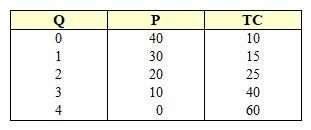 The marginal revenue of the second unit of output in Exhibit 8-2 is:
The marginal revenue of the second unit of output in Exhibit 8-2 is:
A) 10.
B) 20.
C) 30.
D) 40.
E) 60.
 The marginal revenue of the second unit of output in Exhibit 8-2 is:
The marginal revenue of the second unit of output in Exhibit 8-2 is:A) 10.
B) 20.
C) 30.
D) 40.
E) 60.

فتح الحزمة
افتح القفل للوصول البطاقات البالغ عددها 175 في هذه المجموعة.
فتح الحزمة
k this deck
44
Assume a monopolist charges a price corresponding to the intersection of the marginal cost and marginal revenue curves. If this price is between its average variable cost and average total cost curves, the firm will:
A) earn an economic profit.
B) continue to operate in the short run.
C) shut down.
D) all of the above are true.
A) earn an economic profit.
B) continue to operate in the short run.
C) shut down.
D) all of the above are true.

فتح الحزمة
افتح القفل للوصول البطاقات البالغ عددها 175 في هذه المجموعة.
فتح الحزمة
k this deck
45
At the long-run equilibrium level of output, the monopolist's marginal cost will:
A) exceed price.
B) equal price.
C) be less than price.
D) be less than marginal revenue.
A) exceed price.
B) equal price.
C) be less than price.
D) be less than marginal revenue.

فتح الحزمة
افتح القفل للوصول البطاقات البالغ عددها 175 في هذه المجموعة.
فتح الحزمة
k this deck
46
Which of the following statements best describe the price, output, and profit conditions of monopoly?
A) Price will equal marginal cost at the profit-maximizing level of output and profits will be positive in the long-run.
B) Price will always equal average variable cost in the short-run and either profits or losses may result in the long run.
C) In the long-run, positive economic profit will be earned.
D) All of the above are true.
A) Price will equal marginal cost at the profit-maximizing level of output and profits will be positive in the long-run.
B) Price will always equal average variable cost in the short-run and either profits or losses may result in the long run.
C) In the long-run, positive economic profit will be earned.
D) All of the above are true.

فتح الحزمة
افتح القفل للوصول البطاقات البالغ عددها 175 في هذه المجموعة.
فتح الحزمة
k this deck
47
Suppose a monopolist's demand curve lies below its average variable cost curve. The firm will:
A) stay in operation in the short-run.
B) earn an economic profit.
C) earn an economic profit in the long run.
D) shut down.
A) stay in operation in the short-run.
B) earn an economic profit.
C) earn an economic profit in the long run.
D) shut down.

فتح الحزمة
افتح القفل للوصول البطاقات البالغ عددها 175 في هذه المجموعة.
فتح الحزمة
k this deck
48
A monopolist can earn an economic profit only when:
A) marginal cost equals marginal revenue.
B) marginal cost equals price.
C) average total cost is less than price.
D) all of the above.
A) marginal cost equals marginal revenue.
B) marginal cost equals price.
C) average total cost is less than price.
D) all of the above.

فتح الحزمة
افتح القفل للوصول البطاقات البالغ عددها 175 في هذه المجموعة.
فتح الحزمة
k this deck
49
Under monopoly, a firm:
A) is a price taker.
B) maximizes profit by setting marginal cost equal to marginal revenue.
C) will shut down in the short-run if price falls short of average total cost.
D) always earns a pure economic profit.
A) is a price taker.
B) maximizes profit by setting marginal cost equal to marginal revenue.
C) will shut down in the short-run if price falls short of average total cost.
D) always earns a pure economic profit.

فتح الحزمة
افتح القفل للوصول البطاقات البالغ عددها 175 في هذه المجموعة.
فتح الحزمة
k this deck
50
A monopolist earns an economic profit only when:
A) average total cost equals than price.
B) marginal cost equals price.
C) marginal revenue equals price.
D) average total cost is less than price.
A) average total cost equals than price.
B) marginal cost equals price.
C) marginal revenue equals price.
D) average total cost is less than price.

فتح الحزمة
افتح القفل للوصول البطاقات البالغ عددها 175 في هذه المجموعة.
فتح الحزمة
k this deck
51
If marginal cost exceeds marginal revenue, a profit-maximizing monopolist will:
A) restrict output to increase the price even higher.
B) raise price and expand output to increase profit.
C) lower price and expand output to increase profit.
D) attempt to maintain this position because it is consistent with profit maximization.
A) restrict output to increase the price even higher.
B) raise price and expand output to increase profit.
C) lower price and expand output to increase profit.
D) attempt to maintain this position because it is consistent with profit maximization.

فتح الحزمة
افتح القفل للوصول البطاقات البالغ عددها 175 في هذه المجموعة.
فتح الحزمة
k this deck
52
Exhibit 8-1 Monopolist's demand curve 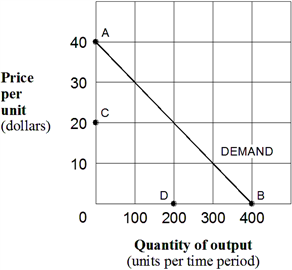 Which of the following points in Exhibit 8-1 would not lie on the marginal revenue curve corresponding to the monopolist's straight-line demand curve?
Which of the following points in Exhibit 8-1 would not lie on the marginal revenue curve corresponding to the monopolist's straight-line demand curve?
A) A.
B) B.
C) C.
D) C and B.
 Which of the following points in Exhibit 8-1 would not lie on the marginal revenue curve corresponding to the monopolist's straight-line demand curve?
Which of the following points in Exhibit 8-1 would not lie on the marginal revenue curve corresponding to the monopolist's straight-line demand curve?A) A.
B) B.
C) C.
D) C and B.

فتح الحزمة
افتح القفل للوصول البطاقات البالغ عددها 175 في هذه المجموعة.
فتح الحزمة
k this deck
53
Assume a monopolist's marginal cost and marginal revenue curves intersect and the demand curve passes above its average total cost curve. The firm will:
A) make an economic profit.
B) stay in operation in the short run, but shut down in the long run.
C) shut down in the short run.
D) lower the price.
A) make an economic profit.
B) stay in operation in the short run, but shut down in the long run.
C) shut down in the short run.
D) lower the price.

فتح الحزمة
افتح القفل للوصول البطاقات البالغ عددها 175 في هذه المجموعة.
فتح الحزمة
k this deck
54
Exhibit 8-1 Monopolist's demand curve 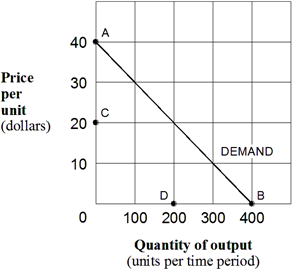 In Exhibit 8-1, the marginal revenue curve corresponding to the monopolist's demand curve would be a straight line drawn between points:
In Exhibit 8-1, the marginal revenue curve corresponding to the monopolist's demand curve would be a straight line drawn between points:
A) A to B.
B) A to C.
C) A to D.
D) C to B.
E) C to D.
 In Exhibit 8-1, the marginal revenue curve corresponding to the monopolist's demand curve would be a straight line drawn between points:
In Exhibit 8-1, the marginal revenue curve corresponding to the monopolist's demand curve would be a straight line drawn between points:A) A to B.
B) A to C.
C) A to D.
D) C to B.
E) C to D.

فتح الحزمة
افتح القفل للوصول البطاقات البالغ عددها 175 في هذه المجموعة.
فتح الحزمة
k this deck
55
Both a perfectly competitive firm and a monopolist:
A) always earn an economic profit.
B) maximize profit by setting marginal cost equal to marginal revenue.
C) maximize profit by setting marginal cost equal to average total cost.
D) are price takers.
A) always earn an economic profit.
B) maximize profit by setting marginal cost equal to marginal revenue.
C) maximize profit by setting marginal cost equal to average total cost.
D) are price takers.

فتح الحزمة
افتح القفل للوصول البطاقات البالغ عددها 175 في هذه المجموعة.
فتح الحزمة
k this deck
56
Exhibit 8-1 Monopolist's demand curve 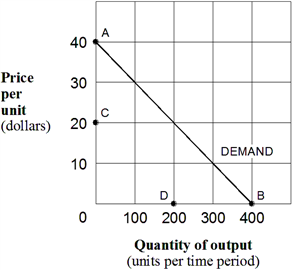 At an output of 100 units, marginal revenue for a monopolist with the demand curve shown in Exhibit 8-1 would be:
At an output of 100 units, marginal revenue for a monopolist with the demand curve shown in Exhibit 8-1 would be:
A) positive.
B) zero.
C) negative.
D) infinity.
 At an output of 100 units, marginal revenue for a monopolist with the demand curve shown in Exhibit 8-1 would be:
At an output of 100 units, marginal revenue for a monopolist with the demand curve shown in Exhibit 8-1 would be:A) positive.
B) zero.
C) negative.
D) infinity.

فتح الحزمة
افتح القفل للوصول البطاقات البالغ عددها 175 في هذه المجموعة.
فتح الحزمة
k this deck
57
A monopolist will maximize profits by:
A) setting his price as high as possible.
B) setting his price at the level that will maximize per-unit profit.
C) producing the output where marginal revenue equals marginal cost.
D) producing the output where price equals marginal cost.
A) setting his price as high as possible.
B) setting his price at the level that will maximize per-unit profit.
C) producing the output where marginal revenue equals marginal cost.
D) producing the output where price equals marginal cost.

فتح الحزمة
افتح القفل للوصول البطاقات البالغ عددها 175 في هذه المجموعة.
فتح الحزمة
k this deck
58
A profit-maximizing monopolist will continue expanding output as long as:
A) marginal revenue exceeds marginal cost.
B) marginal revenue is positive.
C) the cost of producing an additional unit exceeds the marginal revenue derived from the unit.
D) economic profit is more than zero.
A) marginal revenue exceeds marginal cost.
B) marginal revenue is positive.
C) the cost of producing an additional unit exceeds the marginal revenue derived from the unit.
D) economic profit is more than zero.

فتح الحزمة
افتح القفل للوصول البطاقات البالغ عددها 175 في هذه المجموعة.
فتح الحزمة
k this deck
59
Exhibit 8-2 Demand and cost information for a monopoly 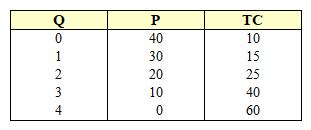 Refer to Exhibit 8-2. Using the rule that focuses on the marginal approach to maximizing profits, the monopolist maximizes profit by choosing price equal to:
Refer to Exhibit 8-2. Using the rule that focuses on the marginal approach to maximizing profits, the monopolist maximizes profit by choosing price equal to:
A) $40.
B) $20.
C) $0.
D) $10.
E) $30.
 Refer to Exhibit 8-2. Using the rule that focuses on the marginal approach to maximizing profits, the monopolist maximizes profit by choosing price equal to:
Refer to Exhibit 8-2. Using the rule that focuses on the marginal approach to maximizing profits, the monopolist maximizes profit by choosing price equal to:A) $40.
B) $20.
C) $0.
D) $10.
E) $30.

فتح الحزمة
افتح القفل للوصول البطاقات البالغ عددها 175 في هذه المجموعة.
فتح الحزمة
k this deck
60
A monopolist will earn economic profits as long as his price exceeds:
A) marginal revenue.
B) average fixed cost.
C) average variable cost.
D) average total cost.
A) marginal revenue.
B) average fixed cost.
C) average variable cost.
D) average total cost.

فتح الحزمة
افتح القفل للوصول البطاقات البالغ عددها 175 في هذه المجموعة.
فتح الحزمة
k this deck
61
A monopolist earning economic profit in the short run determines that at its present level of output, marginal revenue is $23 and marginal cost is $30. Which of the following should the firm do to increase profit?
A) Raise price and lower output.
B) Lower price and lower output.
C) Raise price and raise output.
D) Lower price and raise output.
E) Lower output, but leave price unchanged.
A) Raise price and lower output.
B) Lower price and lower output.
C) Raise price and raise output.
D) Lower price and raise output.
E) Lower output, but leave price unchanged.

فتح الحزمة
افتح القفل للوصول البطاقات البالغ عددها 175 في هذه المجموعة.
فتح الحزمة
k this deck
62
A monopoly:
A) faces the market demand curve which is downward sloping.
B) has a marginal revenue curve which slopes downward and lies below its demand curve.
C) will maximize profits by producing an output level where MR = MC.
D) all of the above.
A) faces the market demand curve which is downward sloping.
B) has a marginal revenue curve which slopes downward and lies below its demand curve.
C) will maximize profits by producing an output level where MR = MC.
D) all of the above.

فتح الحزمة
افتح القفل للوصول البطاقات البالغ عددها 175 في هذه المجموعة.
فتح الحزمة
k this deck
63
Exhibit 8-6 Monopoly 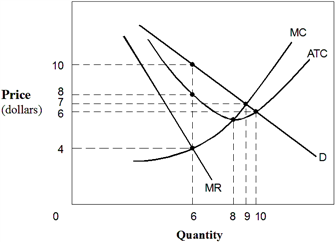 Exhibit 8-6 indicates that a monopolist maximizes profits at output equal to:
Exhibit 8-6 indicates that a monopolist maximizes profits at output equal to:
A) 0.
B) 6.
C) 8.
D) 9.
E) 10.
 Exhibit 8-6 indicates that a monopolist maximizes profits at output equal to:
Exhibit 8-6 indicates that a monopolist maximizes profits at output equal to:A) 0.
B) 6.
C) 8.
D) 9.
E) 10.

فتح الحزمة
افتح القفل للوصول البطاقات البالغ عددها 175 في هذه المجموعة.
فتح الحزمة
k this deck
64
Exhibit 8-5 Demand and cost data for a monopolist 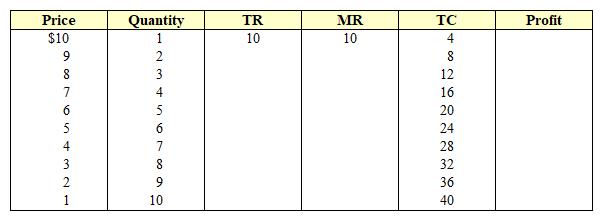 By calculating the data provided in Exhibit 8-5, how much is the profit if the firm decides to produce 7 units?
By calculating the data provided in Exhibit 8-5, how much is the profit if the firm decides to produce 7 units?
A) 0.
B) 24.
C) 16.
D) 12.
E) 6.
 By calculating the data provided in Exhibit 8-5, how much is the profit if the firm decides to produce 7 units?
By calculating the data provided in Exhibit 8-5, how much is the profit if the firm decides to produce 7 units?A) 0.
B) 24.
C) 16.
D) 12.
E) 6.

فتح الحزمة
افتح القفل للوصول البطاقات البالغ عددها 175 في هذه المجموعة.
فتح الحزمة
k this deck
65
If marginal costs increase, a monopolist will:
A) decrease price and increase output.
B) decrease both price and output.
C) increase price and decrease output.
D) increase both price and output.
E) keep both price and output at the same level.
A) decrease price and increase output.
B) decrease both price and output.
C) increase price and decrease output.
D) increase both price and output.
E) keep both price and output at the same level.

فتح الحزمة
افتح القفل للوصول البطاقات البالغ عددها 175 في هذه المجموعة.
فتح الحزمة
k this deck
66
Exhibit 8-3 Demand and cost curves for GeneTech, a monopolist with a patented vaccine 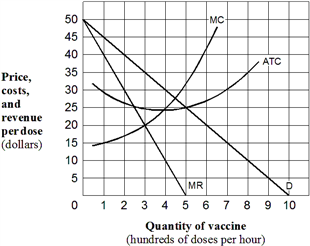 In Exhibit 8-3, what is the maximum hourly profit that GeneTech can earn from its vaccine?
In Exhibit 8-3, what is the maximum hourly profit that GeneTech can earn from its vaccine?
A) $1,500.
B) $3,000.
C) $4,500.
D) $10,500.
 In Exhibit 8-3, what is the maximum hourly profit that GeneTech can earn from its vaccine?
In Exhibit 8-3, what is the maximum hourly profit that GeneTech can earn from its vaccine?A) $1,500.
B) $3,000.
C) $4,500.
D) $10,500.

فتح الحزمة
افتح القفل للوصول البطاقات البالغ عددها 175 في هذه المجموعة.
فتح الحزمة
k this deck
67
What should a profit maximizing monopolist do if she is currently producing where MC
A) Increase output until MC = MR.
B) Decrease output until MC = MR.
C) Shut down in the long run.
D) Keep producing at this level.
E) Operate only in the short run.
A) Increase output until MC = MR.
B) Decrease output until MC = MR.
C) Shut down in the long run.
D) Keep producing at this level.
E) Operate only in the short run.

فتح الحزمة
افتح القفل للوصول البطاقات البالغ عددها 175 في هذه المجموعة.
فتح الحزمة
k this deck
68
A monopoly firm can sell its fourth unit of output for a price of $250. In order to sell more than five units, it must expect to receive a price:
A) equal to $250.
B) greater than $250.
C) less than $250.
D) equal to $340.
E) the price is impossible to calculate with the information given.
A) equal to $250.
B) greater than $250.
C) less than $250.
D) equal to $340.
E) the price is impossible to calculate with the information given.

فتح الحزمة
افتح القفل للوصول البطاقات البالغ عددها 175 في هذه المجموعة.
فتح الحزمة
k this deck
69
Exhibit 8-6 Monopoly 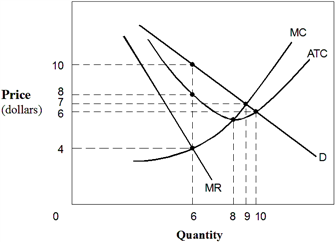 The maximum possible total monopoly profit in Exhibit 8-6 is:
The maximum possible total monopoly profit in Exhibit 8-6 is:
A) $60.
B) $36.
C) $24.
D) $18.
E) $12.
 The maximum possible total monopoly profit in Exhibit 8-6 is:
The maximum possible total monopoly profit in Exhibit 8-6 is:A) $60.
B) $36.
C) $24.
D) $18.
E) $12.

فتح الحزمة
افتح القفل للوصول البطاقات البالغ عددها 175 في هذه المجموعة.
فتح الحزمة
k this deck
70
Using the rule that focuses on the marginal approach to maximizing profits, a monopolist charges a price where the:
A) output sold is maximized.
B) ATC curve is minimized.
C) MR = MC.
D) MR = 0.
A) output sold is maximized.
B) ATC curve is minimized.
C) MR = MC.
D) MR = 0.

فتح الحزمة
افتح القفل للوصول البطاقات البالغ عددها 175 في هذه المجموعة.
فتح الحزمة
k this deck
71
If a monopolist finds that at the present level of output marginal revenue exceeds marginal cost, the firm should:
A) shut down.
B) expand output.
C) maintain the current output.
D) reduce output (but still produce).
E) raise prices.
A) shut down.
B) expand output.
C) maintain the current output.
D) reduce output (but still produce).
E) raise prices.

فتح الحزمة
افتح القفل للوصول البطاقات البالغ عددها 175 في هذه المجموعة.
فتح الحزمة
k this deck
72
Exhibit 8-4 Demand and cost curves for a monopolist 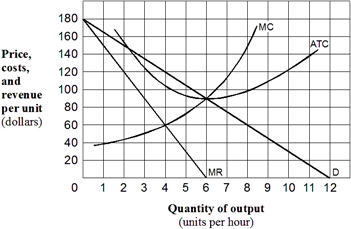 As shown in Exhibit 8-4, in order to maximize its profit (or minimize its loss), what price should the monopoly charge for its product?
As shown in Exhibit 8-4, in order to maximize its profit (or minimize its loss), what price should the monopoly charge for its product?
A) $60 per unit.
B) $90 per unit.
C) $120 per unit.
D) $150 per unit.
 As shown in Exhibit 8-4, in order to maximize its profit (or minimize its loss), what price should the monopoly charge for its product?
As shown in Exhibit 8-4, in order to maximize its profit (or minimize its loss), what price should the monopoly charge for its product?A) $60 per unit.
B) $90 per unit.
C) $120 per unit.
D) $150 per unit.

فتح الحزمة
افتح القفل للوصول البطاقات البالغ عددها 175 في هذه المجموعة.
فتح الحزمة
k this deck
73
Exhibit 8-3 Demand and cost curves for GeneTech, a monopolist with a patented vaccine 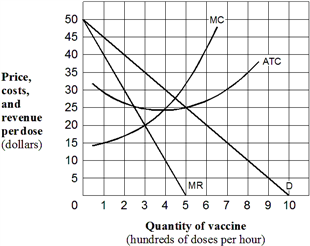 In Exhibit 8-3, how much vaccine should GeneTech produce to maximize its profit?
In Exhibit 8-3, how much vaccine should GeneTech produce to maximize its profit?
A) 300 doses per hour.
B) 400 doses per hour.
C) Between 400 and 500 doses per hour.
D) 500 doses per hour.
 In Exhibit 8-3, how much vaccine should GeneTech produce to maximize its profit?
In Exhibit 8-3, how much vaccine should GeneTech produce to maximize its profit?A) 300 doses per hour.
B) 400 doses per hour.
C) Between 400 and 500 doses per hour.
D) 500 doses per hour.

فتح الحزمة
افتح القفل للوصول البطاقات البالغ عددها 175 في هذه المجموعة.
فتح الحزمة
k this deck
74
The profit-maximizing output level for a monopolist is where the:
A) price is maximized.
B) output sold is maximized.
C) ATC curve is minimized.
D) maximum efficiency is achieved.
E) MR = MC.
A) price is maximized.
B) output sold is maximized.
C) ATC curve is minimized.
D) maximum efficiency is achieved.
E) MR = MC.

فتح الحزمة
افتح القفل للوصول البطاقات البالغ عددها 175 في هذه المجموعة.
فتح الحزمة
k this deck
75
Which of the following is true for a monopolist?
A) The firm has a perfectly elastic demand curve.
B) The firm has a perfectly inelastic demand curve.
C) The straight-line demand curve is above the marginal revenue curve.
D) The marginal revenue curve is above the demand curve.
E) All of the above.
A) The firm has a perfectly elastic demand curve.
B) The firm has a perfectly inelastic demand curve.
C) The straight-line demand curve is above the marginal revenue curve.
D) The marginal revenue curve is above the demand curve.
E) All of the above.

فتح الحزمة
افتح القفل للوصول البطاقات البالغ عددها 175 في هذه المجموعة.
فتح الحزمة
k this deck
76
Exhibit 8-4 Demand and cost curves for a monopolist 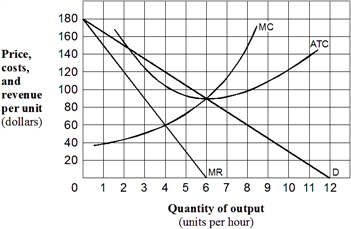 As shown in Exhibit 8-4, in order to maximize its profit (or minimize its loss), how much output should the monopoly produce?
As shown in Exhibit 8-4, in order to maximize its profit (or minimize its loss), how much output should the monopoly produce?
A) 2 units per hour.
B) 4 units per hour.
C) 6 units per hour.
D) 8 units per hour.
 As shown in Exhibit 8-4, in order to maximize its profit (or minimize its loss), how much output should the monopoly produce?
As shown in Exhibit 8-4, in order to maximize its profit (or minimize its loss), how much output should the monopoly produce?A) 2 units per hour.
B) 4 units per hour.
C) 6 units per hour.
D) 8 units per hour.

فتح الحزمة
افتح القفل للوصول البطاقات البالغ عددها 175 في هذه المجموعة.
فتح الحزمة
k this deck
77
Exhibit 8-5 Demand and cost data for a monopolist 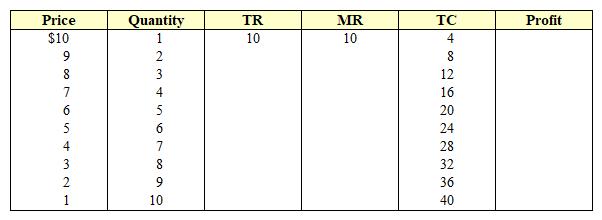 Refer to Exhibit 8-5. The demand schedule and cost schedule for a monopolist are provided. Which output level maximizes profit?
Refer to Exhibit 8-5. The demand schedule and cost schedule for a monopolist are provided. Which output level maximizes profit?
A) 2.
B) 6.
C) 4.
D) 5.
E) 7.
 Refer to Exhibit 8-5. The demand schedule and cost schedule for a monopolist are provided. Which output level maximizes profit?
Refer to Exhibit 8-5. The demand schedule and cost schedule for a monopolist are provided. Which output level maximizes profit?A) 2.
B) 6.
C) 4.
D) 5.
E) 7.

فتح الحزمة
افتح القفل للوصول البطاقات البالغ عددها 175 في هذه المجموعة.
فتح الحزمة
k this deck
78
Exhibit 8-3 Demand and cost curves for GeneTech, a monopolist with a patented vaccine 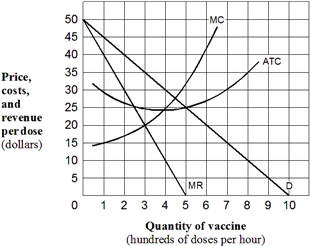 As shown in Exhibit 8-3, in order to maximize its profit, what price should GeneTech charge for its vaccine?
As shown in Exhibit 8-3, in order to maximize its profit, what price should GeneTech charge for its vaccine?
A) $20 per dose.
B) $25 per dose.
C) $35 per dose
D) $50 per dose.
 As shown in Exhibit 8-3, in order to maximize its profit, what price should GeneTech charge for its vaccine?
As shown in Exhibit 8-3, in order to maximize its profit, what price should GeneTech charge for its vaccine?A) $20 per dose.
B) $25 per dose.
C) $35 per dose
D) $50 per dose.

فتح الحزمة
افتح القفل للوصول البطاقات البالغ عددها 175 في هذه المجموعة.
فتح الحزمة
k this deck
79
Although a monopoly can charge any price it wishes, it chooses:
A) the highest price.
B) price equal to marginal cost.
C) the price that maximizes profit.
D) competitive prices.
E) a fair price.
A) the highest price.
B) price equal to marginal cost.
C) the price that maximizes profit.
D) competitive prices.
E) a fair price.

فتح الحزمة
افتح القفل للوصول البطاقات البالغ عددها 175 في هذه المجموعة.
فتح الحزمة
k this deck
80
Exhibit 8-6 Monopoly 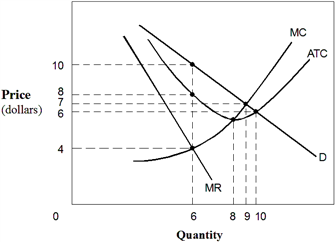 The monopoly price that maximizes profits in Exhibit 8-6 is:
The monopoly price that maximizes profits in Exhibit 8-6 is:
A) $4.
B) $6.
C) $7.
D) $8.
E) $10.
 The monopoly price that maximizes profits in Exhibit 8-6 is:
The monopoly price that maximizes profits in Exhibit 8-6 is:A) $4.
B) $6.
C) $7.
D) $8.
E) $10.

فتح الحزمة
افتح القفل للوصول البطاقات البالغ عددها 175 في هذه المجموعة.
فتح الحزمة
k this deck








